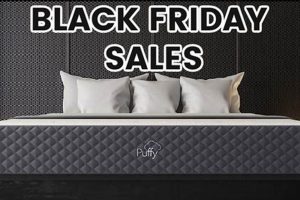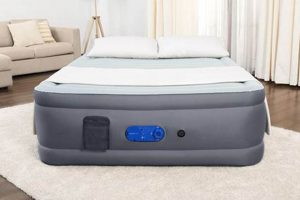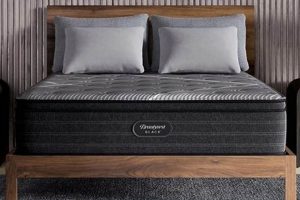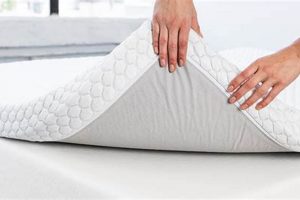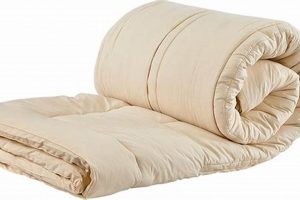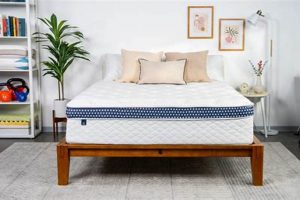Hybrid mattresses combine the support of innerspring coils with the comfort of foam layers, typically memory foam or latex. An accessible option offers a balance of these features at a lower price point, making it attractive to budget-conscious consumers seeking a comfortable and supportive sleep surface. For example, a model with a basic coil system and a thinner comfort layer would qualify.
This product category addresses a significant demand in the mattress market, providing an alternative to expensive all-foam or high-end hybrid options. Historically, consumers had to choose between the affordability of innerspring mattresses and the enhanced comfort of foam. The emergence of these options bridges this gap, offering a more compelling value proposition. The benefit lies in accessing improved sleep quality without exceeding a predetermined budget.
The following sections will delve into the key factors to consider when evaluating these products, including construction materials, coil type, foam density, and warranty information. The aim is to provide a framework for assessing value and identifying a suitable sleep solution.
Essential Considerations for Value-Conscious Hybrid Mattress Selection
This section provides crucial guidance for consumers seeking a value-driven hybrid mattress, emphasizing factors that contribute to both affordability and quality. Careful evaluation of these points will aid in making an informed purchasing decision.
Tip 1: Research Coil System Gauge: The coil gauge indicates the thickness of the steel. Lower gauge numbers (e.g., 12.5) indicate thicker, firmer coils, potentially offering enhanced support and durability. A higher gauge number (e.g., 14.5) signifies thinner coils, which may offer a softer feel but potentially reduced longevity.
Tip 2: Evaluate Foam Density: Higher foam density generally correlates with increased durability and resistance to body impressions. Aim for a memory foam density of at least 3 pounds per cubic foot for optimal support. Lower density foams may deteriorate more quickly.
Tip 3: Analyze Layer Construction: Understand the specific arrangement of layers within the mattress. A well-constructed option often includes a supportive base layer, a coil system, and a comfort layer. Examine the thickness and composition of each layer.
Tip 4: Scrutinize Warranty Terms: A longer warranty period typically indicates the manufacturer’s confidence in the product’s durability. Review the specific terms and conditions of the warranty, including coverage for sagging or defects.
Tip 5: Consider Edge Support: Edge support refers to the firmness around the perimeter of the mattress. Enhanced edge support prevents sagging and allows for full utilization of the sleep surface. Look for reinforced edges or coils around the mattress’s perimeter.
Tip 6: Investigate Trial Periods: Many manufacturers offer trial periods, allowing consumers to test the mattress at home. Take advantage of this opportunity to assess comfort and support before committing to a purchase.
Tip 7: Compare Pricing Strategically: Analyze prices across multiple retailers and consider seasonal sales or promotional offers. Focus on comparing models with similar features and specifications to ensure an accurate assessment of value.
Selecting a value-driven hybrid mattress requires diligent research and careful consideration of key features. By prioritizing factors such as coil system gauge, foam density, and warranty terms, consumers can maximize their investment and achieve improved sleep quality.
The following section will provide a comparative analysis of available models in the market. This aims to illustrate practical application of the previously detailed guidelines.
1. Coil Count
Coil count, referring to the number of individual coils within a hybrid mattress’s support core, is a frequently cited specification that influences perceived value. In the context of an affordable option, manufacturers often balance coil count against other factors such as coil gauge and foam density to achieve a target price point. A higher coil count, generally speaking, can contribute to enhanced support and reduced motion transfer, distributing weight more evenly across the sleeping surface. However, the material quality and arrangement of these coils are equally important, potentially mitigating the benefits of sheer quantity. For example, a model might boast a high coil count using thinner gauge steel, resulting in diminished long-term durability compared to a mattress with fewer, but sturdier, coils.
A direct, positive correlation between coil count and sleep quality in an affordable hybrid mattress is not guaranteed. The type of coil (e.g., Bonnell, pocketed) significantly impacts performance. Pocketed coils, for instance, operate independently, minimizing motion transfer more effectively than interconnected Bonnell coils, even with a lower overall count. A hybrid mattress labeled as “best affordable” should strike a balance between coil count, coil type, and the quality of the surrounding foam layers, ensuring these elements work in concert to provide adequate support and pressure relief. Marketing materials may emphasize a high number, but consumers must critically evaluate the holistic mattress construction to accurately assess its value proposition.
Ultimately, while coil count is a measurable attribute, it should not be the sole determinant in selecting a value-priced hybrid mattress. The interplay between coil count, coil gauge, coil type, and the quality of comfort layers dictates the final performance. The “best affordable hybrid mattress” designation necessitates careful consideration of these interconnected factors, ensuring an informed purchasing decision that prioritizes overall sleep experience and long-term value over a single, potentially misleading, specification.
2. Foam Density
Foam density plays a pivotal role in determining the long-term comfort and durability of a hybrid mattress, significantly influencing whether a model can justifiably be labeled among the “best affordable hybrid mattress” options. Density, typically measured in pounds per cubic foot (lbs/ft), indicates the amount of material packed into a given volume of foam. Higher density foams generally exhibit greater resistance to compression and deformation over time, translating to improved support retention and a prolonged lifespan. In contrast, lower density foams are more susceptible to softening and sagging, potentially compromising the mattress’s ability to adequately support the sleeper and maintain spinal alignment. For example, a hybrid mattress with a 2.0 lbs/ft memory foam comfort layer may initially feel plush, but is more likely to develop lasting body impressions compared to a similar mattress incorporating 4.0 lbs/ft foam. Therefore, foam density serves as a critical indicato
r of a mattress’s ability to deliver sustained comfort and support, particularly relevant for budget-conscious consumers seeking long-term value.
The selection of foam density within an affordable hybrid mattress often represents a deliberate trade-off between cost and performance. Manufacturers seeking to minimize production expenses may opt for lower density foams, enabling them to offer a more competitive price point. However, this strategy inherently reduces the mattress’s lifespan and overall value proposition. The performance of supporting innerspring coils will be irrelevant should the foam component fail quickly. Consumers seeking an affordable solution must be aware of this relationship and prioritize models that strike a balance between cost and foam density. Careful examination of product specifications and independent reviews can provide valuable insights into the actual density of the foams used, allowing consumers to assess the long-term value and durability of the mattress. For example, even within a specific price range, variations in foam density can significantly impact the longevity and support characteristics of different models.
In summary, foam density is an essential characteristic to consider when evaluating a hybrid mattress, especially within the affordable category. While a lower price tag may be appealing, sacrificing foam density can lead to premature sagging and reduced support, ultimately diminishing the mattress’s value. Consumers prioritizing a “best affordable hybrid mattress” should thoroughly investigate foam densities, recognizing that a slightly higher upfront investment in a model with denser foams can translate to substantial cost savings and improved sleep quality over the long term. Recognizing the foam’s ability to maintain its structural integrity under prolonged use and weight will allow the buyer to correctly assess any candidate mattress.
3. Edge Support
Edge support, referring to the structural reinforcement along the perimeter of a mattress, directly influences the usable sleep surface and overall stability, factors critical in determining if a product merits consideration within the “best affordable hybrid mattress” category. Inadequate edge support causes the mattress to compress excessively near the edges, creating a roll-off sensation and reducing the accessible area. This is particularly relevant for individuals sharing a bed or those who utilize the edge of the mattress for sitting or support. A poorly supported edge can lead to a feeling of instability, affecting sleep quality and potentially posing safety concerns. For instance, a consumer purchasing a full-size mattress for space efficiency might find the usable surface effectively reduced to that of a twin if edge support is lacking, negating the intended benefit. Conversely, enhanced edge support maximizes the usable sleep surface, contributing to a more comfortable and secure experience. Therefore, edge support is not merely a cosmetic feature, but an essential element influencing practical usability.
Affordable hybrid mattresses frequently employ varying strategies to address edge support. Some manufacturers utilize reinforced coils around the perimeter, while others encase the mattress edges in dense foam. Each approach presents trade-offs between cost and effectiveness. Foam encasement, while potentially less expensive, may not provide the same level of long-term support as reinforced coils. The durability of the edge support is also dependent on the quality of materials and construction techniques used. A mattress advertised as having “enhanced” edge support should undergo scrutiny to determine the actual methods employed and the effectiveness of those methods. A visual inspection can reveal the presence of reinforced coils, while pressing along the edge can indicate the firmness and stability. The degree of edge support directly correlates to the user’s experience, especially over time, highlighting its importance in overall satisfaction.
In conclusion, edge support is a significant factor when evaluating an affordable hybrid mattress. Its presence and quality influence the usable sleep surface, stability, and longevity. While price is often a primary consideration, neglecting edge support can result in a compromised sleep experience and reduced value in the long term. A genuinely “best affordable hybrid mattress” will incorporate effective edge support mechanisms that enhance usability and extend the mattress’s lifespan. Consumers should prioritize models that demonstrate a commitment to providing adequate edge support, balancing cost considerations with the practical benefits of a stable and fully usable sleep surface. Therefore, the assessment of edge support is vital when selecting such products.
4. Warranty Length
Warranty length serves as a critical indicator of a manufacturer’s confidence in the longevity and durability of a hybrid mattress, thereby directly impacting its perceived value, especially in the context of a “best affordable hybrid mattress.” A more extended warranty period typically suggests higher-quality materials and construction, mitigating the risk of premature degradation and associated costs for the consumer.
- Material Quality Implication
A longer warranty often reflects the use of more durable materials. For instance, high-density foams and resilient coil systems are less prone to sagging or breakdown, allowing manufacturers to offer extended coverage periods. A shorter warranty may indicate cost-saving measures in material selection, increasing the likelihood of early failure and rendering the “affordable” aspect less beneficial over time. An example would be a mattress with a 10-year warranty versus one with only a 1-year warranty, alluding to vastly different material compositions.
- Construction Integrity
Extended warranties can also signal superior construction techniques. Meticulous assembly and rigorous quality control processes contribute to mattress longevity. A manufacturer willing to guarantee their product for an extended period likely employs robust construction methods to minimize potential defects. For example, reinforced edge support and secure layer bonding are hallmarks of well-constructed mattresses, often reflected in the warranty duration. A mattress with reinforced edge support will typically last longer.
- Risk Mitigation for Consumers
A more extended warranty offers increased protection against manufacturing defects and premature wear and tear. This is particularly valuable for consumers seeking an affordable option, as it reduces the financial risk associated with purchasing a lower-priced product. Should the mattress exhibit sagging or other covered defects within the warranty period, the consumer is entitled to repair or replacement, thereby safeguarding their investment. Consumers have greater risk in the mattress with the shorter warranty.
- Marketing and Brand Reputation
Longer warranties can also serve as a marketing tool, enhancing brand reputation and consumer confidence. A manufacturer willing to stand behind their product for an extended period signals a commitment to quality and customer satisfaction. This can differentiate a product within the competitive affordable hybrid mattress market, influencing purchasing decisions and building long-term brand loyalty. Mattress manufacturers that back their product with long warranties build better reputations.
In essence, warranty length functions as a proxy for quality and durability when assessing an affordable hybrid mattress. While price remains a primary consideration, a robust warranty offers peace of mind and mitigates the risks associated with purchasing a value-priced product. Consumers should carefully examine the warranty terms and conditions, recognizing that a more extended coverage period often reflects higher-quality materials and construction, contributing to a more sustainable and cost-effective sleep solution. In this way, it factors in to the true overall cost.
5. Trial Period
A trial period, offered by many mattress retailers, represents a critical opportunity for consumers to assess the suitability of a mattress in a home environment. This becomes particularly significant when evaluating what constitutes the “best affordable hybrid mattress,” as subjective comfort and long-term support are difficult to ascertain in a showroom.
- Subjective Comfort Assessment
Trial periods permit individuals to experience the mattress over an extended duration, allowing them to evaluate its comfort characteristics based on their specific sleep preferences and physical needs. This includes assessing pressure relief, temperature regulation, and overall sleep quality, factors that are highly personal and difficult to judge accurately in a brief showroom visit. For example, an individual might find a mattress initially comfortable but discover that it provides inadequate lumbar support after several weeks of use. A trial period allows this issue to be identified and addressed through return or exchange policies. In this context, the trial period’s primary role is to enable the objective observation of whether the mattress facilitates sufficient rest.
- Long-Term Support Evaluation
The long-term support capabilities of a mattress are not immediately apparent during initial testing. A trial period enables consumers to assess how well the mattress maintains its shape and support over time, identifying potential issues such as sagging or the development of body impressions. This is crucial in evaluating the durability and value proposition of an affordable hybrid mattress. A mattress that initially feels supportive may degrade quickly, negating the cost savings associated with its affordability. Therefore, the trial period provides a practical means of assessing the mattress’s ability to deliver sustained support and comfort.
- Return and Exchange Flexibility
The terms and conditions of the trial period, specifically the return and exchange policies, are essential considerations. Consumers should carefully examine these policies to understand the process for returning the mattress if it proves unsuitable, including any associated fees or restrictions. A generous return policy minimizes the risk of purchasing an unsuitable mattress, enhancing the overall value proposition. The inclusion of a risk-free period will increase a consumer’s propensity to purchase. This feature is often paramount to any purchase for the discerning buyer of the ‘best affordable hybrid mattress’ product.
The trial period is an indispensable tool for consumers seeking the “best affordable hybrid mattress.” By providing an opportunity to evaluate subjective comfort, long-term support, and return/exchange flexibility, the trial period empowers consumers to make informed purchasing decisions and maximize the value of their investment. The ability to return a product deemed unsuitable is the perfect antidote to any shortcomings that a mattress might exhibit.
6. Price Point
Price point forms the foundational constraint when defining the “best affordable hybrid mattress.” It is the primary determinant establishing the scope of available options. The definition of “affordable” is subjective, varying with individual financial circumstances, however, it invariably represents the upper limit a consumer is willing or able to spend. A lower price point necessitates compromises in materials, construction, or features, impacting the overall quality and longevity of the mattress. The interplay between the price point and these compromises is critical in determining whether a mattress truly represents value. For instance, a mattress marketed aggressively at a very low price may utilize lower-density foams or thinner-gauge coils, resulting in diminished comfort and reduced lifespan. Such a product, while initially appealing due to its low cost, may prove more expensive in the long run due to the need for premature replacement. Therefore, price point is the initial filter, but it must be balanced against other value-determining factors. A product’s long term value is often dependent on the initial price.
The correlation between price point and component quality is a significant consideration. Higher-priced affordable hybrid mattresses typically feature denser foam layers, more robust coil systems, and enhanced edge support. These features contribute to improved comfort, durability, and overall sleep quality. Conversely, lower-priced options often sacrifice these elements to achieve a competitive price point. The effect is tangible: a mattress with a higher price point within the “affordable” category may provide superior spinal support, minimizing back pain and promoting restful sleep, while a cheaper model may lack adequate support, resulting in discomfort and disrupted sleep patterns. Real-world examples abound, from budget-friendly mattresses developing significant sagging within a year to slightly more expensive options retaining their shape and support for several years. Consumer reviews often highlight this disparity, underscoring the practical significance of evaluating the trade-offs associated with different price points. Reviews of the product often contain the key details that a consumer can use.
Ultimately, understanding the relationship between price point and the components of a hybrid mattress allows for a more informed purchase. Identifying the “best affordable hybrid mattress” involves balancing the desired features and expected lifespan against the available budget. A higher price point within the affordable range often translates to increased value through superior materials and construction, leading to improved sleep quality and longer-term cost savings. This careful evaluation ensures that the initial investment yields lasting benefits and avoids the pitfalls of prioritizing cost above all else. The key is to identify the highest-quality mattress attainable at the maximum price a consumer can reasonably afford.
Frequently Asked Questions About the Best Affordable Hybrid Mattress
This section addresses common inquiries concerning hybrid mattresses, specifically focusing on value-oriented options.
Question 1: What constitutes a hybrid mattress?
A hybrid mattress integrates both innerspring coils and foam layers, typically memory foam or latex, to provide a balance of support and comfort.
Question 2: How does coil count impact the performance of an affordable hybrid mattress?
Coil count, while important, is not the sole determinant of mattress quality. The type and gauge of the coils also significantly influence support and durability.
Question 3: What foam density is recommended in an affordable hybrid mattress?
A memory foam density of at least 3 pounds per cubic fo
ot is generally recommended to ensure adequate support and longevity.
Question 4: Why is edge support important in a hybrid mattress?
Effective edge support maximizes the usable sleep surface and prevents sagging, contributing to a more stable and comfortable sleep experience.
Question 5: How should warranty length be considered when selecting a hybrid mattress?
A longer warranty period often indicates a manufacturer’s confidence in the durability of their product and provides greater protection against premature defects.
Question 6: What is the significance of a trial period when purchasing an affordable hybrid mattress?
A trial period allows for at-home assessment of comfort and support, mitigating the risk of purchasing an unsuitable mattress.
Careful consideration of these factors will contribute to an informed purchasing decision.
The next section will provide a summary of key considerations.
In Summary
This exploration of the “best affordable hybrid mattress” has underscored the multi-faceted considerations essential for informed decision-making. Key factors, encompassing coil specifications, foam densities, edge reinforcement, warranty protections, and trial availability, have been identified as crucial determinants of long-term value and sleep satisfaction. Price, while central to the affordability criterion, must be evaluated in conjunction with these qualitative aspects to ensure a purchase that aligns with individual needs and expectations.
The process of acquiring a hybrid mattress suitable for a limited budget necessitates due diligence. Consumers are encouraged to prioritize comprehensive product assessment, focusing on quantifiable specifications and verifiable performance claims, as well as fully exploiting any available trial periods. By conscientiously weighing these factors, a selection can be made that represents not merely a cost-effective solution, but an investment in sustained comfort and restorative sleep.


